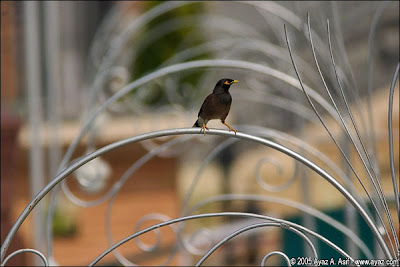A bird, perched on one of the lamp posts, also watches the ceremony
by Umair Ghani
Pakistani flags on our side and the Indians’ on their side flutter above a densely barbed wire. This wire fades into long distance forming an immense curve along the border that lies on both sides of Wahga. Visitors to the show are watchfully escorted to concrete pavilions where flag-lowering ceremony is about to begin. Foreign visitors are allotted front rows on either side of the metalled road. The Iron gates separating the border are also painted in Pakistan, India flags. These gates are tightly closed and guarded. Crowd roars . . .

Gradually swelling, the crowd chants slogans and dances on high-pitched patriotic songs. Young men and women carrying national flags run up and down the road. Moderate spectators stand high on multi tiered pavilions and wave gestures of friendship and goodwill to the people on the other side of the fence. Atmosphere is charged with powerful expressions of nationalism as all wait for final parade to begin, a commanding expression of national pride and rivalry between the two countries.
“Awareness and interaction between India and Pakistan helped hatred to cool down”, Abdul Samad, one member of the parade party tells me, “and with that, former style and gesticulation of the parade also changed. It used to be very aggressive a couple of years ago. Now both governments realize that antagonism must calm down.”
The Indian sentiments in Mridula Kapur’s article “Sundown Madness” narrate a slightly hostile account of this magnificent activity from the other side of the border, “...the striking feature of the occasion was not the smart drill, but the attempt to outdo each other in showing their anger and contempt against each other. Soldiers raised their boots to show the soles to others across the border, chests were puffed out and touched others’ when they came face to face, and feet were stamped so hard that the road must require weekly repairs!” Quite aggressive, one agrees, but if viewed in wake of pulling crowds for entertainment and a mere display of nationalism, it may not seem as intimidating as Kapur portrays it. Mridula further comments, “Ordinary men and women were turned into ferocious warriors wanting to rush to the defense of their respective countries. Faces flushed, the people behaved as if in a tantric trance. Each shout of command, louder than the previous, further enhanced the atmosphere of hatred.”

But despite this entire huffing and puffing, and banging boots for display of assertive gestures, the flames of anger and contempt have mostly been extinguished. Only fumes of smoldering aggression and national pride whirl in the charged atmosphere, forcing people of India and Pakistan to celebrate freedom in their very own distinctive way. And this signifies the gist of this regular activity at the border, as Esben Agersnap, a Danish writer quotes,” what makes this ceremony so special is the highly ritualized aggression displayed by the soldiers of both sides - with huge crowds cheering them on both sides try to drown out the other side by playing loud patriotic pro-Pakistani or pro-Hindustani songs! Here the soldiers have just begun pulling down their respective flags.”

Lowering down flags at borders is a military routine, and why not in style when you have so much to show the world. Soldiers gracefully attired, in black and khaki, wear rich colored turbans above their heads and broad chests laden with silver and bronze medallions. Throwing ropes high in the air, saluting their respective flags, and as the sun goes down in the west; they wrap fluttering flags in grand manner. Holding in up next to their hearts, they bring it back to their posts and the ceremony comes to end.
People on both sides rush to the iron gates and greet each other by blowing kisses in the air. Yet Mirdula Kapur remains skeptic about this daily ritual at the border, “Finally it was over. The crowd fell silent, drained of energy. What it left behind in the minds was sure to last a long time. What was the purpose of the entire proceeding? It bred nothing but intolerance between two neighbors who could surely do without more animosity. Artificial borders separate two peoples who have been brothers till recently and daily events like these are only helping those wanting the relations to remain sour.”
Sweet or sour, the impression it leaves behind is sure to last long, with a flare of national pride and awareness that we must guard our freedom at every cost, while also showing respect to the sovereignty of our neighbor.
Photos: Courtesy Asif Ayaz
Note: This post already appeared in our blog at WordPress. It has been updated now and is being inserted for our readers on Google's.
YOUR COMMENT IS IMPORTANT
DO NOT UNDERESTIMATE THE POWER OF YOUR COMMENT
Note: This post already appeared in our blog at WordPress. It has been updated now and is being inserted for our readers on Google's.


No comments:
Post a Comment